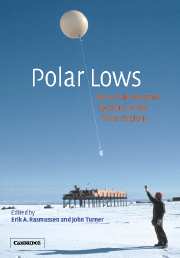5 - Numerical simulation
Published online by Cambridge University Press: 07 December 2009
Summary
The Arctic
Introduction
Numerical models of the atmosphere, which predict future conditions from an analysis of an initial state, have proved to be a tool of growing importance in the study and forecasting of polar lows. To some degree, the life cycles of some polar lows are now simulated operationally by numerical weather prediction (NWP) centres. Some special cases of polar lows have been simulated more extensively in an a posteriori, non-operational mode with models suited for this purpose. Such simulations have provided a new form of data for the study of the formation and evolution of these vortices.
The history of the development of NWP, along with the growth of computing capacity in super-computers, is well known. For a long time the resolution of the numerical models was too coarse to describe polar lows. A breakthrough for the simulation of polar lows came in a polar low project organized by the Norwegian Meteorological Institute (DNMI) in the first half of the 1980s (Lystad, 1986; Rasmussen and Lystad, 1987). As part of this project, a mesoscale NWP system was established (Grønås et al., 1987b; Grønås and Hellevik, 1982; Nordeng, 1986), which gave the first realistic numerical simulations of polar lows (Grønås et al., 1987a; Nordeng, 1987). As operational NWP systems were further developed, reliable guidance for the prediction of polar lows was eventually advanced at several meteorological centres.
- Type
- Chapter
- Information
- Polar LowsMesoscale Weather Systems in the Polar Regions, pp. 405 - 500Publisher: Cambridge University PressPrint publication year: 2003



